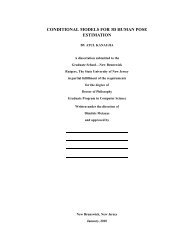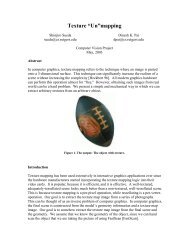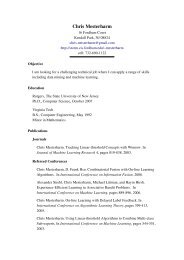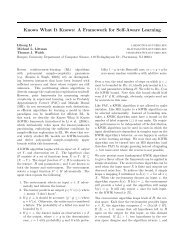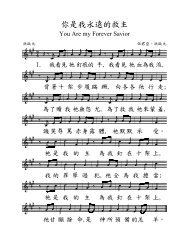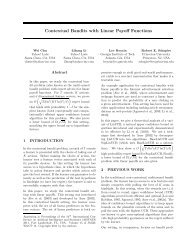Composition theorems in communication complexity
Composition theorems in communication complexity
Composition theorems in communication complexity
You also want an ePaper? Increase the reach of your titles
YUMPU automatically turns print PDFs into web optimized ePapers that Google loves.
But note that this holds for any r ∈ G, thus also for the average of them. That is,<br />
∑<br />
χ i (s)χ j (t) = 1 ( ∑ )( ∑<br />
)<br />
χ i (r)χ j (r) χ i (s ′ )χ j (t<br />
|G|<br />
′ ) = 0,<br />
(s,t)∈T<br />
r∈G<br />
(s ′ ,t ′ )∈T<br />
by the standard orthogonality property of different irreducible characters.<br />
⇐: S<strong>in</strong>ce ∑ (s,t)∈T χ i(s)χ j (t) = 0, ∀i ≠ j, we know that T as a function is <strong>in</strong> span{χ i ⊗χ i :<br />
i}. Note that any l<strong>in</strong>ear comb<strong>in</strong>ation of G <strong>in</strong>variant functions is also G <strong>in</strong>variant. Thus it<br />
rema<strong>in</strong>s to check that each basis χ i ⊗ χ i is G <strong>in</strong>variant, which is easy to see:<br />
This f<strong>in</strong>ishes the proof.<br />
χ i (rs)χ i (rt) = χ i (r)χ i (s)χ i (r)χ i (t) = χ i (s)χ i (t).<br />
Another nice property of Abelian groups is that the orthogonality condition condition<br />
implies the regularity one.<br />
Proposition 4. For an Abelian group G, if either T y,y is G <strong>in</strong>variant for all y or S x,x is G<br />
<strong>in</strong>variant for all x, then G|{g(x, y) : x ∈ X, y ∈ Y }.<br />
Proof. Note that T y,y (s, s) = |{x : g(x, y) = s}|, thus T y,y be<strong>in</strong>g G <strong>in</strong>variant implies that<br />
|{x : g(x, y) = s}| = |{x : g(x, y) = t}| for all s, t ∈ G. Thus the column y <strong>in</strong> matrix<br />
[g(x, y)] x,y , when viewed as a multiset, is equal to G repeated |Y |/|G| times. Therefore the<br />
whole multiset {g(x, y) : x ∈ X, y ∈ Y } is a multiple of G as well.<br />
What we f<strong>in</strong>ally get for Abelian groups is the follow<strong>in</strong>g.<br />
Corollary 4. For a sign matrix A = [f(g(x, y))] x,y and an Abelian group G, if d(f, span(Ch Easy )) =<br />
Ω(1), and the multisets S x,x′ = {(g(x, y), g(x ′ , y)) : y ∈ Y } and T y,y′ = {(g(x, y), g(x, y ′ )) :<br />
x ∈ X} are G <strong>in</strong>variant for any (x, x ′ ) and any (y, y ′ ), then<br />
√<br />
MN<br />
Q(A) ≥ log 2<br />
max i∈Hard ‖[χ i (g(x, y))] x,y ‖ − O(1).<br />
5.4 Block composed functions<br />
We now consider a special class of functions g: block composed functions. Suppose the group<br />
G is a product group G = G 1 × · · · × G t , and g(x, y) = (g 1 (x 1 , y 1 ), · · · , g t (x t , y t )) where x =<br />
(x 1 , · · · , x t ) and y = (y 1 , · · · , y t ). That is, both x and y are decomposed <strong>in</strong>to t components<br />
and the i-th coord<strong>in</strong>ate of g(x, y) only depends on the i-th components of x and y. The<br />
tensor structure makes all the computation easy. Theorem 8 can be generalized to the general<br />
product group case for arbitrary groups G i .<br />
Def<strong>in</strong>ition 7. The ɛ-approximate degree of a class function f on product group G 1 ×· · ·×G t ,<br />
denoted by d ɛ (f), is the m<strong>in</strong>imum d s.t. ‖f −f ′ ‖ ∞ ≤ ɛ, where f ′ can be represented as a l<strong>in</strong>ear<br />
comb<strong>in</strong>ation of irreducible characters with at most d non-identity component characters.<br />
Theorem 12. For sign matrix<br />
A = [f(g 1 (x 1 , y 1 ), · · · , g t (x t , y t )] x,y<br />
where all g i satisfy their orthogonality conditions, we have<br />
Q(A) ≥ m<strong>in</strong><br />
{χ i},S<br />
∑<br />
i∈S<br />
log 2<br />
√<br />
size(Mgi )<br />
deg(χ i )‖M χi◦g i<br />
‖ − O(1)<br />
where the m<strong>in</strong>imum is over all S ⊆ [n] with |S| > deg 1/3 (f), and all non-identity irreducible<br />
characters χ i of G i .


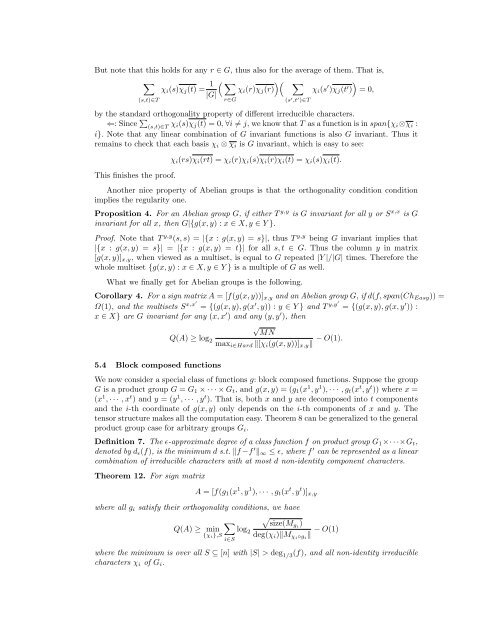
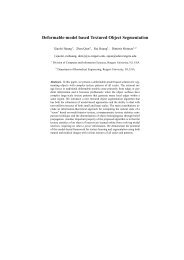
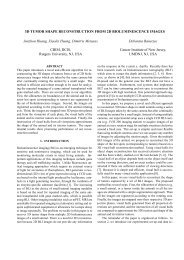
![Twitter[PDF]](https://img.yumpu.com/25710531/1/190x143/twitterpdf.jpg?quality=85)
